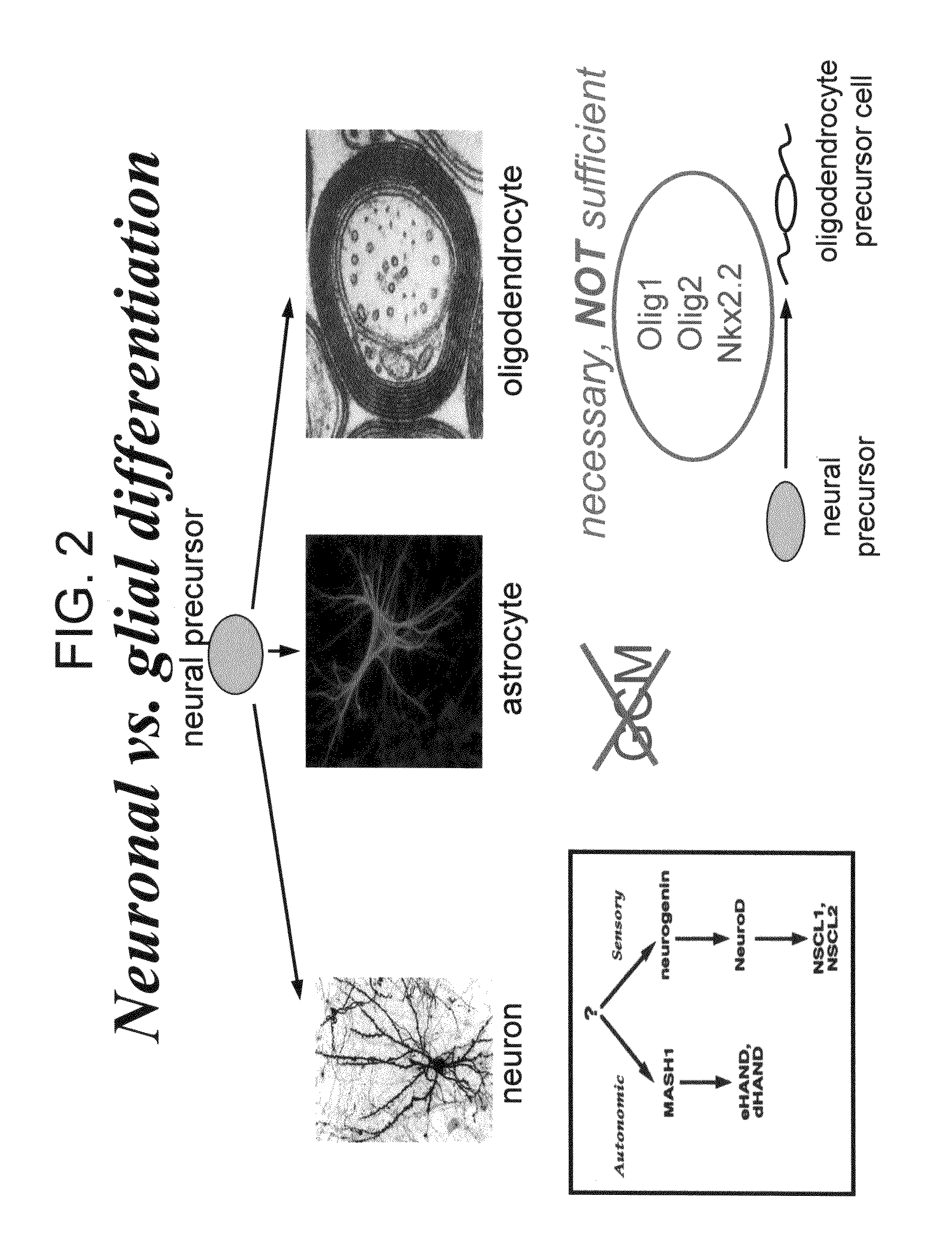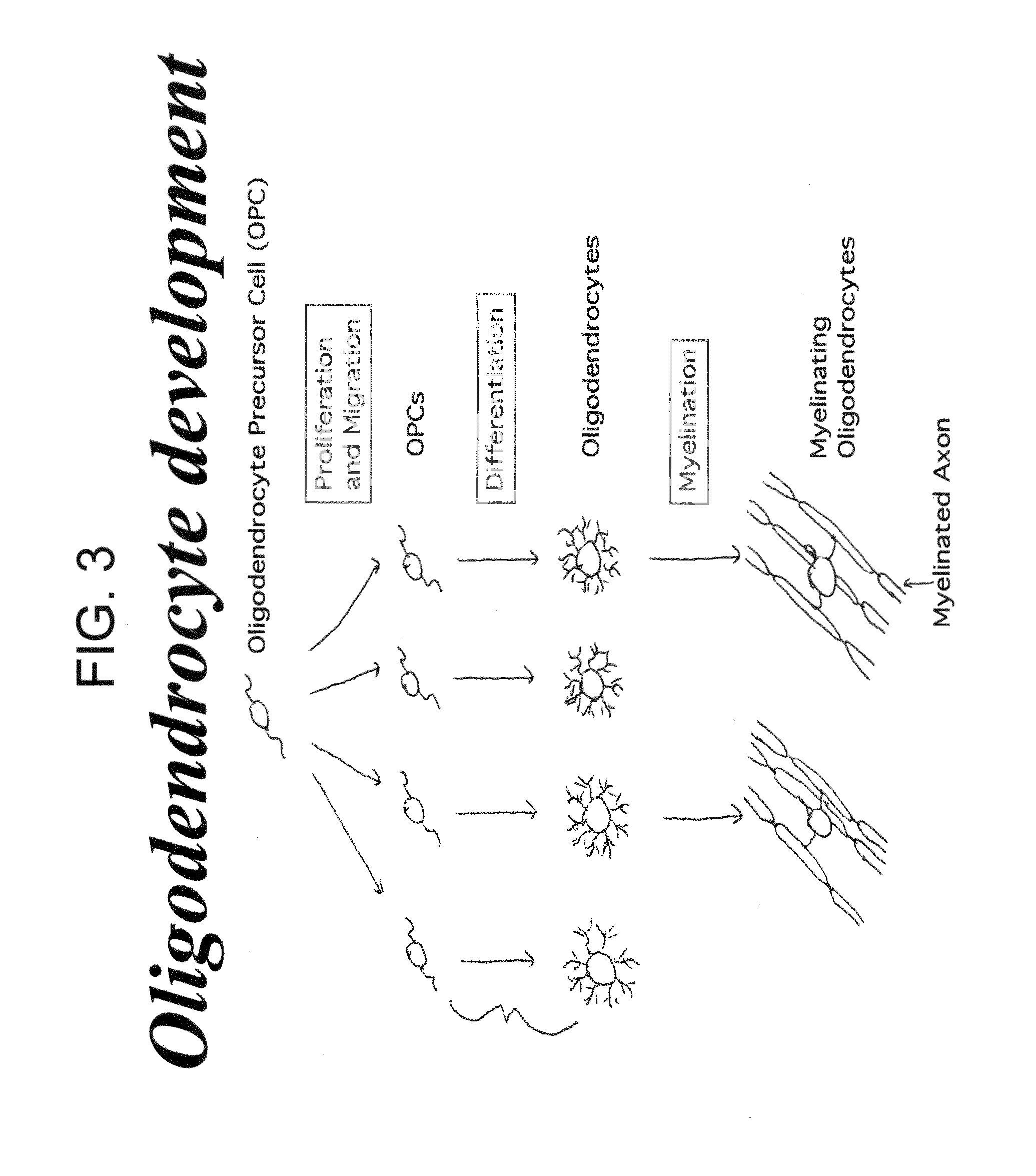Cell cycle regulation and differentiation
a cell cycle and cell cycle technology, applied in cell culture active agents, instruments, drug compositions, etc., can solve the problems of affecting the remyelination process
- Summary
- Abstract
- Description
- Claims
- Application Information
AI Technical Summary
Benefits of technology
Problems solved by technology
Method used
Image
Examples
example 1
Expression Profiles of OPCs and OLs
[0215]Expression profiles for undifferentiated OPCs and differentiating OLs in culture were obtained at various time points (FIG. 5). Highly regulated genes recapitulated in vivo expression (FIG. 6). Based on the expression profiles obtained from OPCs differentiating into OLs, two tables were compiled depicting the top 50 OL upregulated and top 50 OL-specific genes (FIG. 7). In comparison of the two lists, it was observed that 16 genes occur in both lists (FIG. 7) and a total of 52 genes were identified as not previously known to be expressed in OLs (FIG. 7). Furthermore, from these 52 genes, 13 were identified as demonstrating white-matter enriched expression patterns (FIG. 7). Moreover, 22 genes were identified as both OL-regulated and highly linked to MS loci (FIGS. 9, 10). Of these SEPP1 was one of the most strongly induced OL genes that also demonstrated white matter specific expression. SEPP1 maintains normal Se+ levels including in the CNS, ...
example 2
Screening Assay: Transcription Factors
[0218]In a screening assay to determine the role of transcription factors in OL differentiation, OPCs in culture were co-transfected with expression vectors that encoded a marker (e.g., GFP) and transcription factors identified above, or pools of siRNA designed to reduce expression of targeted transcription factors. Cells were plated in differentiation or proliferation medium (i.e., + / −PDGF:+ / −T3): Cells were incubated for several days and subsequently stained for early and late myelin markers, e.g., MBP and MOG respectively. PDGF promotes proliferation while T3 promotes differentiation (FIG. 22).
[0219]Various transcription factors tested, included early versus late transcription factors, such as SOX10, ZFP536 and UHRF1 (FIGS. 23-26). Knock down of SOX10 and ZFP536 reduced myelin gene expression, while overexpression of UHRF1 also reduced myelin gene expression, as demonstrated by MBP and MOG staining (FIG. 27, 28). Also, knockdowns for SOX10 an...
example 3
p57Kip2's Role in OL Differentiation
[0221]Oligodendrocyte development is a key aspect for any method of treating a myelin disorder, because oligodendrocyte cells are the primary cells responsible for myelin repair in the CNS. In an in vitro model system of OL differentiation, where OL differentiation from a pure population of committed, proliferating oligodendrocyte precursor cells (OPCs) was monitored, p57Kip2 was one of the most rapidly induced genes upon initiation of OL differentiation from OPCs (FIG. 31). This induction was also observed in vivo by comparing p57Kip2 expression levels in acutely purified OPCs and newly formed OLs. In addition, p57Kip2 is expressed in myelinated, white matter areas of the central nervous system (FIG. 32). P73 which promotes OL differentiation also induces p57Kip2 expression and p57Kip2 is a known inhibitor of the cell cycle, inhibiting formation of Cdk / cyclin complexes (FIG. 33). Furthermore, p57Kip2 mutants display several cell cycle exit relate...
PUM
| Property | Measurement | Unit |
|---|---|---|
| time | aaaaa | aaaaa |
| time | aaaaa | aaaaa |
| thick | aaaaa | aaaaa |
Abstract
Description
Claims
Application Information
 Login to View More
Login to View More - R&D
- Intellectual Property
- Life Sciences
- Materials
- Tech Scout
- Unparalleled Data Quality
- Higher Quality Content
- 60% Fewer Hallucinations
Browse by: Latest US Patents, China's latest patents, Technical Efficacy Thesaurus, Application Domain, Technology Topic, Popular Technical Reports.
© 2025 PatSnap. All rights reserved.Legal|Privacy policy|Modern Slavery Act Transparency Statement|Sitemap|About US| Contact US: help@patsnap.com



